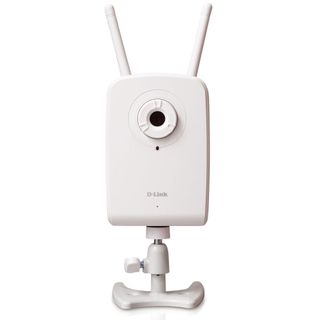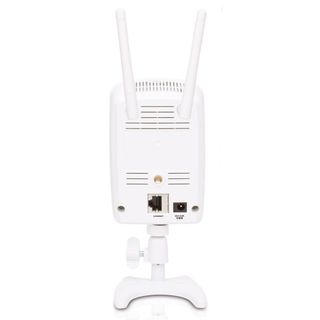PC-Based Home Security: Do It Yourself
We test products that let you monitor and protect your home without the need for an outside security company's services: D-Link, Axis, Logitech, Schlage
D-Link DCS-1130 Wireless N Network Camera
The DCS-1130 is not made to blend in. Stark white and measuring 1.5” x 3.2” x 4.7” with the two antennas off, the 1130 is about as big as your hand. The W-shaped stand is bulky but stable. Overall, the camera struck me as slightly cheap-looking perhaps because of the thick, plastic focus ring around the lens. The bad news is that the focus ring is there at long, requiring another setup step that’s easy to miss. The good news is that, because the lens does feature a variable focal length, images tend to be a bit sharper and avoid some of the fringe blurring common in low-end network cams.

There’s not much to say about the back of the DCS-1130. In addition to the two antenna ports, you’ll find an Ethernet connector, power adapter port, and a threaded mounting point for optional mounting kits. The 1130 does come with a pair of sheetrock screws for securing the camera base to a wall or ceiling.

The DCS-1130 was D-Link’s original 11n camera. Lottery winners can feel free to buy it from D-Link directly for $219.99. Amazon currently lists it for $138.99, which is far more reasonable for the feature set. (If you have structured wiring or some other reason not to care about WiFi, you can find the Ethernet-only DCS-1100 for just under $100.) There’s no question that you want/need a network camera with 802.11n support. I’ve tried 11g units in the past, and they simply can’t sustain consistent, acceptable results. There just isn’t enough stable bandwidth, especially in environments with lots of competing RF traffic.
I should also point out D-Link’s excellent and surprisingly sensitive microphone. Recordings I made from the camera downstairs were able to clearly convey songs and even regular talking from upstairs. I wouldn’t say the mic is more sensitive than human hearing, but it’s impressively close.
I’ll detail the DCS-1130’s inner operations on the next page, but suffice it to say here that, like nearly all network cameras, the 1130 comes with an internal Web server. This allows users to view live video from anywhere they can use a Web browser…sort of. The camera supports Motion JPEG and MPEG-4 formats, but if you use any browser besides Internet Explorer, you’ll only be able to receive MJPEG. I also noticed several setup screens within the camera’s pages that wouldn’t display properly unless in IE. Either way, the DCS-1130 specifies a maximum performance of 30 frames per second (fps) at 640 x 480.
Installation is very straightforward. Just pop in the Installation CD-ROM and follow the instructions. D-Link guides you through all the cable connections required during setup, WPS linking to your router/access point (if your hardware supports it), and a camera reset. That’s it. When I moved the 1130 to a new location, it went back on the wireless network without a hitch.
Sign up to get the BEST of Tom's Guide direct to your inbox.
Get instant access to breaking news, the hottest reviews, great deals and helpful tips.
Note: In the process of mixing and matching networking gear, we discovered that D-Link’s old DIR-635 Draft N router doesn’t always play nice with the company’s own cameras. The DCS-1130 would occasionally drop off the network, and the DCS-930L would outright crash the router. These problems vanished when we switched to the newer DIR-825 router.
Current page: D-Link DCS-1130 Wireless N Network Camera
Prev Page PC-Based Home Security: Do It Yourself Next Page Inside the DCS-1130William Van Winkle is a freelance editor and tech journalist who has been writing for more than 20 years. His work has appeared on Tom's Guide, Tom's Hardware, Tom's IT Pro, AMD, Seagate, Computer Shopper, and more. He is also an author, writing poetry, short stories, and science fiction and fantasy books.
-
thegreathuntingdolphin William,Reply
Cool article. I have been looking into security cameras for the home, especially ones that are outdoor or pointed outdoor (some noobcakes have been hitting cars and driving off in my apartment complex). I am a bit dissapointed that most of these don't really seem good for outdoors or for long distance night recording (I know some of these said up to 20 to 30 feet but in my experience that means they are really only clear at 10-15 feet). Foscam has a number of cheap IP cameras with pan and tilt, are for outdoor use or longer night vision use. Do you have any experience with them?
The Schlage system is looking good. Hopefully others will jump on the bandwagon and get more products out. I am glad the Schlage deadbolt is not motorized like the Kwikset one since it greatly improves the battery life. Whenever I get a house I am definitly going to do something like the LiNK system.
I too am disappointed in the current IP-based offerings. The perfect IP-based camera seems illusive. Too many have half the features. Most the N wireless ones seems to lack really good night vision capabilities and the ones with good night vision capabilities usually are G only or have N are stupidly expensive. -
Nice article!Reply
It’s interesting how IP cameras and emerging technology, such as Jabbakam.com enable average people to transform a home surveillance system into a shared camera network that can be accessed by whoever is invited by the camera owners, to view the footage via an online account accessible from anywhere at anytime.
Jabbakam is a system where you have complete access to your footage, to manage and share as you want. You can easily create a network (public or private) and invite your friends or neighbours to join and add their cameras so that you all have access to the footage of the cameras as a group.
You can set up alerts so that you will be notified by email or sms if your camera detects something happening in front of it, and you have peace of mind that your camera is doing its job and working, thanks to a monitoring system that checks your camera status every few minutes. The Jabbakam website offers users a lot more functionality besides. Check us out, and join us on Facebook.com/jabbakam and Twitter (@jabbakam). We’d love to hear from you! -
It is still an annual subscription of $80 a year it is only very well hidden by Logitech (just try and buy it and you will figure it out).Reply
The hiding of subscription cost itself is terrible, but also that they sell you just part of a product is outragous. It makes me mad and takes some of the joy of owning such a cool (and expensive) product. -
I'll never buy a product that requires a subscription or is dependent on another site or "the cloud". Excellent article, except for the WPS thing.. WTH is that?Reply
